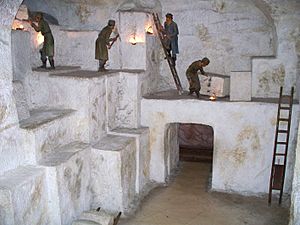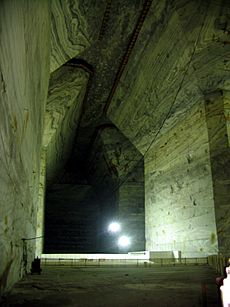Salt mining facts for kids
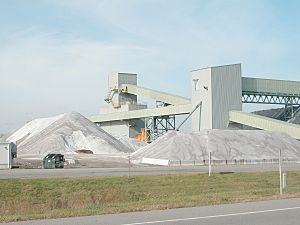
Salt mining extracts natural salt deposits from underground. The mined salt is usually in the form of halite (commonly known as rock salt), and extracted from evaporite formations.
History
Before the advent of the modern internal combustion engine and earth-moving equipment, mining salt was one of the most expensive and dangerous of operations because of rapid dehydration caused by constant contact with the salt (both in the mine passages and scattered in the air as salt dust) and of other problems caused by accidental excessive sodium intake. Salt is now plentiful, but until the Industrial Revolution, it was difficult to come by, and salt was often mined by slaves or prisoners. Life expectancy for the miners was low.
Ancient China was among the earliest civilizations in the world with cultivation and trade in mined salt. They first discovered natural gas when they excavated rock salt. The Chinese writer, poet, and politician Zhang Hua of the Jin dynasty wrote in his book Bowuzhi how people in Zigong, Sichuan, excavated natural gas and used it to boil a rock salt solution. The ancient Chinese gradually mastered and advanced the techniques of producing salt. Salt mining was an arduous task for them, as they faced geographical and technological constraints. Salt was extracted mainly from the sea, and salt works in the coastal areas in late imperial China equated to more than 80 percent of national production. The Chinese made use of natural crystallization of salt lakes and constructed some artificial evaporation basins close to shore. In 1041, during the Song dynasty, a well with a diameter about the size of a bowl and several dozen feet deep was drilled for salt production. In Southwestern China, natural salt deposits were mined with bores that could reach to a depth of more than 1,000 m (3,300 ft), but the yields of salt were relatively low. As salt is a necessity of life, salt mining played a pivotal role as one of the most important sources of the Imperial Chinese government's revenue and state development.
Most modern salt mines are privately operated or operated by large multinational companies such as K+S, AkzoNobel, Cargill, and Compass Minerals.
Mining regions around the world
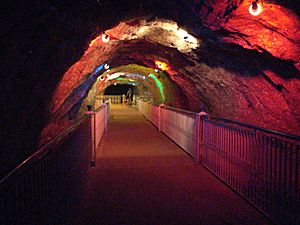
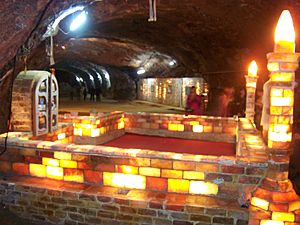
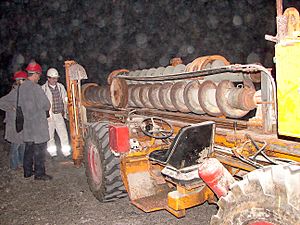
Some notable salt mines include:
| Country | Site(s) |
|---|---|
| Austria | Hallstatt and Salzkammergut. |
| Bosnia and Herzegovina | Tuzla |
| Bulgaria | Provadiya; and Solnitsata, an ancient town which Bulgarian archaeologists regard as the oldest in Europe and the site of a salt-production facility approximately six millennia ago. |
| Canada | Sifto Salt Mine in Goderich, Ontario, which, at 1.5 miles (2.4 km) wide and 2 miles (3.2 km) long, is one of the largest salt mines in the world extending 7 km2 (2.7 sq mi). |
| Colombia | Zipaquirá |
| England | The "-wich towns" of Cheshire and Worcestershire. |
| Ethiopia, Eritrea, Djibouti | Danakil Desert, where manual labor is used. |
| Germany | Rheinberg, Berchtesgaden, Heilbronn |
| Republic of Ireland | Mountcharles |
| Italy | Racalmuto, Realmonte and Petralia Soprana within the production sites managed by Italkali. |
| Morocco | Société de Sel de Mohammedia (Mohammedia Rock Salt company) near Casablanca |
| Northern Ireland | Kilroot, near Carrickfergus, more than a century old and containing passages whose combined length exceeds 25 km. |
| Pakistan | Khewra Salt Mines, the world's second largest salt-mining operation, spanning over 300 km. It was first discovered by a horse of Alexander the Great. The mine is still operation till today. |
| Poland | Wieliczka and Bochnia, both established in the mid-13th century and still operating, mostly as museums. Kłodawa Salt Mine. |
| Romania | Slănic (with Salina Veche, Europe's largest salt mine), Cacica, Ocnele Mari, Salina Turda, Târgu Ocna, Ocna Sibiului, Praid and Salina Ocna Dej. |
| Russia |
|
| Ukraine | Soledar Salt Mine in Soledar, Donetsk oblast. |
| United States |
|
Idiomatic use
In slang, the term salt mines, and especially the phrase back to the salt mines, refers ironically to one's workplace, or a dull or tedious task. This phrase originates from c. 1800 in reference to the Russian practice of sending prisoners to forced labor in Siberian salt mines.
See also
 In Spanish: Mina de sal para niños
In Spanish: Mina de sal para niños
- Salt mines
- Khewra
- Schacht Asse II
- Turda
- Wieliczka
- Windsor
- General
- Salt evaporation pond
- Brine mining
- Injection well
- Salt lake
- Salt dome
- Miner


